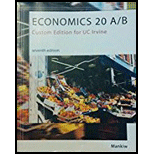
PRINC OF ECONOMICS PKG >CUSTOM<
7th Edition
ISBN: 9781305018549
Author: Mankiw
Publisher: CENGAGE C
expand_more
expand_more
format_list_bulleted
Question
Chapter 21, Problem 3PA
Sub part (a):
To determine
The change in the price of relative commodities.
Sub part (b):
To determine
The change in the price of relative commodities.
Sub part (c):
To determine
The change in the price of relative commodities.
Expert Solution & Answer
Trending nowThis is a popular solution!

Students have asked these similar questions
which article about commond Economic and hor it relate to Principle of Economics?
which one article about utility in an Economics and how this article relate to principle of Economics?
How Command Economics Relate to Principle Of Economics?
Chapter 21 Solutions
PRINC OF ECONOMICS PKG >CUSTOM<
Ch. 21.1 - Prob. 1QQCh. 21.2 - Prob. 2QQCh. 21.3 - Prob. 3QQCh. 21.4 - Prob. 4QQCh. 21 - Prob. 1CQQCh. 21 - Prob. 2CQQCh. 21 - Prob. 3CQQCh. 21 - Prob. 4CQQCh. 21 - Prob. 5CQQCh. 21 - Prob. 6CQQ
Ch. 21 - Prob. 1QRCh. 21 - Prob. 2QRCh. 21 - Prob. 3QRCh. 21 - Prob. 4QRCh. 21 - Prob. 5QRCh. 21 - Prob. 6QRCh. 21 - Prob. 7QRCh. 21 - Prob. 1PACh. 21 - Prob. 2PACh. 21 - Prob. 3PACh. 21 - Prob. 4PACh. 21 - Prob. 5PACh. 21 - Prob. 6PACh. 21 - Prob. 7PACh. 21 - Prob. 8PACh. 21 - Prob. 9PACh. 21 - Prob. 10PACh. 21 - Prob. 11PACh. 21 - Prob. 12PA
Knowledge Booster
Similar questions
- how commond economies relate to principle Of Economics ?arrow_forwardCritically analyse the five (5) characteristics of Ubuntu and provide examples of how they apply to the National Health Insurance (NHI) in South Africa.arrow_forwardCritically analyse the five (5) characteristics of Ubuntu and provide examples of how they apply to the National Health Insurance (NHI) in South Africa.arrow_forward
- Outline the nine (9) consumer rights as specified in the Consumer Rights Act in South Africa.arrow_forwardIn what ways could you show the attractiveness of Philippines in the form of videos/campaigns to foreign investors? Cite 10 examples.arrow_forwardExplain the following terms and provide an example for each term: • Corruption • Fraud • Briberyarrow_forward
- In what ways could you show the attractiveness of a country in the form of videos/campaigns?arrow_forwardWith the VBS scenario in mind, debate with your own words the view that stakeholders are the primary reason why business ethics must be implemented.arrow_forwardThe unethical decisions taken by the VBS management affected the lives of many of their clients who trusted their business and services You are appointed as an ethics officer at Tyme Bank. Advise the management regarding the role of legislation in South Africa in providing the legal framework for business operations.arrow_forward
- Tyme Bank is a developing bank in South Africa and could potentially encounter challenges similar to those faced by VBS in the future. Explain five (5) benefits of applying business ethics at Tyme Bank to prevent similar ethical scandals.arrow_forward1.3. Explain the five (5) ethical challenges that can be associated with the implementation of the National Health Insurance (NHI) in South Africa.arrow_forward1.2. Fourie (2018:211) suggests that Ubuntu emphasises the willingness to share and participate in a community. However, it does not privilege the community over the dignity and life of the individual. With the above in mind, discuss how the implementation of the National Health Insurance (NHI) is a way to uphold the concept of Ubuntu.arrow_forward
arrow_back_ios
SEE MORE QUESTIONS
arrow_forward_ios
Recommended textbooks for you
 Exploring EconomicsEconomicsISBN:9781544336329Author:Robert L. SextonPublisher:SAGE Publications, Inc
Exploring EconomicsEconomicsISBN:9781544336329Author:Robert L. SextonPublisher:SAGE Publications, Inc Economics (MindTap Course List)EconomicsISBN:9781337617383Author:Roger A. ArnoldPublisher:Cengage Learning
Economics (MindTap Course List)EconomicsISBN:9781337617383Author:Roger A. ArnoldPublisher:Cengage Learning




Exploring Economics
Economics
ISBN:9781544336329
Author:Robert L. Sexton
Publisher:SAGE Publications, Inc

Economics (MindTap Course List)
Economics
ISBN:9781337617383
Author:Roger A. Arnold
Publisher:Cengage Learning


